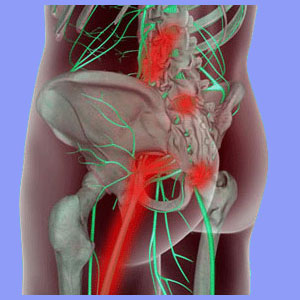
There are structural, nonstructural and disease-related sciatica causes which may be responsible for enacting radicular pain and related neurological symptoms. It is well known that misdiagnosis is a big problem when trying to ascertain the real cause of any back, neck or sciatica pain syndrome. This is because the incidence of many lumbar spinal abnormalities, often mistakenly blamed for sourcing pain, is virtually universal. If the true cause of pain is not discovered and treated, then the patient has little hope of ever finding lasting relief. This goes a long way in explaining why so few of us do achieve cures for our sciatica suffering.
This resource section will provide an overview of the many possible causes of sciatica. We will also take a detailed look at each of these potential sciatica causes in the individual article topics contained below.
Injurious Sciatica Causes
Any significant trauma to the back might damage some of the spinal structures, causing a variety of painful conditions, including sciatica.
Herniated discs might compress a spinal nerve root causing painful symptoms.
Vertebral fractures might also influence proper nerve function, if they create foraminal or central canal stenosis. Sciatica from compression fractures is one of the more common associations between lower body pain and spinal bone breaks.
While these conditions exist in some patients, they typically either resolve without treatment or will heal with proper medical attention. Injury is seldom a cause of ongoing chronic sciatica.
The body is designed to heal when damaged and heal it will.
Many patients endure surgical injury while actually trying to treat their pain. This can result in scar tissue or nerve damage which may create lasting neurological effects. It is a little known fact that a huge number of patients who are eventually diagnosed with nerve damage suffer this trauma while facing spinal surgery. This is yet another reason why invasive back or neck pain treatment should be arduously avoided, if at all possible.
Causes of Sciatica
There are so many possible causes of sciatica. The guides below provide information on the most commonly experienced of these potential causations:
Obesity sciatica is related to disproportionate height and weight ratio.
Sciatica from sitting is one of the most common symptomatic forms of back and leg pain.
Sciatica from crossing legs can make seated sciatica even worse.
Sciatica from standing can limit physicality and job performance for many patients.
Sciatica from lifting surprisingly most commonly involves light loads and routine physical exertions, making it a highly suspect causation.
Sciatica from bending is a fascinating topic, since scientific reality of the anatomy of bending is completely out of line with most patient’s experiences.
Sciatica and varicose veins is not true sciatica, but can mimic many of the symptoms accurately.
Wheelchair sciatica can affect physically-challenged people who still maintain feeling in their legs and buttocks.
Sciatica from driving can occur to due mind and body contributors.
Car accident sciatica is one of the more common causes of injurious sciatic nerve pain.
Sciatica from whiplash may indicate cervical or lumbar injury that must be thoroughly evaluated.
Sciatica at night may occur before bed or once the patient reclines to sleep.
Sciatica in bed can disturb sleep and lead to collateral health consequences.
Poor posture sciatica can typically be treated using conservative care methods.
Sciatica from diabetes is also known as diabetic neuropathy.
Sciatica during pregnancy is sometimes the result of spinal nerve compression related to carrying a baby.
Postpartum sciatica might continue after the birth or may commence once the baby is actually born.
Idiopathic sciatica occurs for no identifiable reasons.
Sex with sciatica can diminish the joy of spending intimate time with a partner.
Sciatica and sports are related topics, since many sports injuries might lead to sciatic nerve troubles.
Sciatica lipoma may result from these common and generally harmless fatty tumors.
Sciatica from lordosis can result from atypical front to back spinal curvatures.
Sciatica from cancer may be another significant result of tumor formation or might occur due to treatment side effects.
Short leg sciatica is linked to a leg length differential.
Sciatica from arthritis is one of the most often demonstrated structural causations in the lumbar spine.
Sciatica bone spurs are inherently related to the arthritic processes.
Sciatica from a herniated disc is another of the most common of all lumbar spinal causations.
Sciatica from chemical radiculitis can occur due to nerve irritation enacted by disc nucleus proteins.
Sciatica from disc disease is one of the least enlightened diagnostic theories, but the condition can occur in cases of extreme deterioration.
Sciatica from spinal stenosis is one of the most difficult types of sciatic nerve symptoms to treat without surgery.
Sciatica from piriformis syndrome denotes pain that is sourced from nerve compression of the fully formed sciatic being impinged upon by the piriformis muscle.
Sciatica from sacroiliac problems might be related to arthritic or soft tissue concerns in this powerful joint.
Ankylosing spondylitis sciatica is just one of the terrible expressions of this autoimmune disorder.
Scoliosis and sciatica can be related due to nerve or spinal cord compression scenarios.
Sciatica muscle imbalances can result from innervation concerns in the lower body regions.
Fibromyalgia sciatica is one of many disabling symptoms associated with FMS.
Bursitis sciatica can result from hip joint problems unilaterally or bilaterally.
Osteoporosis sciatica does not come about directly from low bone density, but may occur once damage is suffered to the vertebrae that might compromise the central or foraminal canal patency.
Sciatica from spondylolisthesis is a common side effect of abnormal vertebral slippage.
A damaged sciatic nerve can lead to a life filled with troublesome symptoms.
Sciatica from a pinched nerve is the usual explanation for traditional expressions in the lower body.
Horseback riding sciatica can diminish the enjoyment of equestrian pastimes.
Vertebral subluxation sciatica might result from movement of the spinal bones from their subjective ideal alignment and positioning.
Spina bifida sciatica can be caused by significant instances of hole formation in the vertebral bones.
Sciatica from flat feet can cause symptoms in some patients, but is often a mistaken causative theory in others. Pronated foot sciatica is possible, but not universally experienced. What about Morton’s toe? Can it also contribute to sciatica?
Spinal syrinx sciatica can come from syringomyelia and hydromyelia conditions higher in the spinal cord.
Can high heels actually cause sciatica? Yes, actually they can.
Sciatica during menstruation can be a monthly torment for women.
RSI or repetitive strain injury is a growing explanation for sciatica, despite little evidence that it exists in most diagnosed patients.
Degenerative Sciatica Causes
Degeneration is the term often given to the various processes which are normally experienced due to age and use. The spinal structures degenerate just like every other part of our physical bodies. The vast majority of spinal degeneration is completely normal, expected and asymptomatic.
Degenerative disc disease is the most common diagnosis, with spinal osteoarthritis not far behind. Specific diagnoses related to osteoarthritis include bone spur formation, often blamed for causing foraminal stenosis, and facet joint syndrome.
Spinal stenosis is another common process which occurs naturally, mostly due to advanced age.
Most of these conditions are not inherently painful and are rarely the source of any significant discomfort in their milder forms. Of course, when the anatomical changes are severe, pain and nerve symptoms may result. However, these instances usually enjoy positive treatment results, since the diagnosis is verifiably valid.
Ischemic Sciatica Causes
One of the more common, yet least diagnosed, causes of chronic nerve pain is certainly ischemic sciatica. The harmless, but incredibly painful, oxygen deprivation sciatica process can occur due to disease or injury. However, the majority of patients demonstrate a version of ischemia which is enacted by the subconscious mind. This is the reason why so many sciatic nerve pain syndromes do not respond well to medical or complementary treatment.
After all, these therapy modalities assume a structural causation for the pain, while all along, the pain is due to a psychoemotional process. Most doctors are not adequately trained to deal with these types of mindbody conditions and typically do not even recognize the telltale signs of psychosomatic pain.
It should be clarified that in cases of mindbody ischemia, the pain is completely real. Just because the root process exists in the mind, does not make the condition any less physical in its expression. This pain is not exaggerated, invented or imagined.
What Really Causes Sciatica?
True sciatica is defined as lower back, buttocks, leg and/or foot pain induced by a spinal source. This does account for a large percentage of patient complaints, but, as previously mentioned, these cases rarely become chronic and treatment-defiant. In fact, when the diagnosis of spinal sciatica is correct, the treatments applied have a fair to good chance of resolving the pain permanently.
Pseudo-sciatica comes from nonspinal sources, either structural, such as the sacroiliac joint or piriformis muscle, or nonstructural, such as diabetes or ischemia. Pseudo versions are actually more prevalent than spinally-enacted sciatic nerve pain syndromes. They also do not respond well to treatment, since the actual reason for the pain is seldom correctly correlated to the expression.
In most cases, the symptoms are incorrectly blamed on what amounts to coincidental lumbar degeneration and treatment fails.
The goal of this article resource section is to provide the reader with all the many possible sciatica causes. Never assume that just because you demonstrate lumbar degeneration, that this is the definitive source of your pain.
Instead, consider all the factors which may be causative or contributory and be sure to seek diagnosis from an objective spinal neurologist. This will help you to separate the benign factors from the pathological ones. Read more about what causes sciatica.
No matter which sciatica causes are affecting you, there is immediate help available from our peer-acclaimed online Cure Back Pain Forever Program. You can get help 24 hours a day from anywhere in the world.






